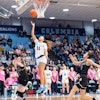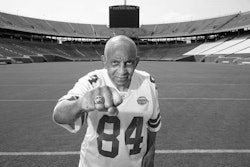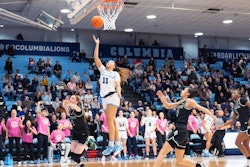Report: Black Football Players Improve Graduation Rates But Still Trail White Counterparts
by Lois Elfman
Academic progress continues for football student-athletes who play in the Football Bowl Subdivision (FBS), but the racial divide continues to widen, according to a new report released Monday by The Institute for Diversity and Ethics in Sport (TIDES).
The study shows overall academic progress continues to climb, but the gap between White and African-American players when it comes to academic performance also continues to widen.
“So many of the African-American student-athletes come from public school systems that are bankrupt educationally,” said Dr. Richard Lapchick, director of TIDES and primary author of Keeping Score When It Counts: Assessing the 2008-09 Bowl-bound College Football Teams — Academic Performance Improves but Race Still Matters.
“They don’t have the technology that some of the suburban or rural schools have,” Lapchick added. “They don’t have the best teachers.”
Lapchick also noted there may also be cultural expectations, which hopefully will shift significantly when President-Elect Barack Obama takes office. “He emphasized academics and was successful,” he says.
There is a 76 percent graduation rate for White football student-athletes at the 120 FBS schools versus 59 percent for African-American football student-athletes. Although this is a significant increase from 50 percent in 2007, the gap between White and Black players rose from 14 percent to 17 percent, the report shows.
Another positive for football players is the fact that African-American football student-athletes graduate at a higher rate than the overall African-American male student population, which is only 38 percent. Although Lapchick drew no conclusions on that differential, indisputable advantages for student-athletes are they have no tuition woes and they are often provided with excellent tutors and other resources not readily available to the average student.
For some schools the disparity in graduation rates between White and African-American football student-athletes was distressingly large.
Twelve schools had graduation success rates among Black football players that were at least 30 percent lower than their White counterparts; 29 schools had rates at least 20 percent lower for Black football athletes than White players.
Praise goes to five schools with higher graduation rates for Black football players over their White counterparts. Those schools include: University of Connecticut, Troy University in Alabama, Florida Atlantic University, University of Oklahoma and Rutgers University.
To prepare this survey, TIDES examines the NCAA Graduation Success Rate reports. It finds Federal Graduation Rates to be flawed and not adequately reflective of behavior patterns of student-athletes, Lapchick told Diverse Monday. The federal rates do not reflect players who transfer from one university to another, those who return to a college after playing eligibility to finish a degree, or those who transfer from a junior college, according to the report.
When TIDES began preparing and releasing graduation rate data, the numbers were dismal for all football student-athletes. Since 2004, when the NCAA put forth Division I Academic Reform, the numbers have improved. With the threat of losing scholarships due to poor academic performance, coaches have become directly involved in the academic progress of their players.
“Now we want to keep the pressure on colleges and universities to maintain and try to increase the academic standards,” Lapchick said. The current Academic Progress Rate (APR) is tied to a target graduation rate of 50 percent.
“We’re going to start putting pressure on the NCAA to increase that graduation rate expectation to 55 percent next year and incrementally move it up,” he said. “The schools are obviously meeting those standards and surpassing them. Goals are to further incentivize the schools to do even better.
“I hope we’re going to see a narrowing of the gap between Black and White student-athletes’ performance,” he added. “That’s my hope.”
The current and past reports can be downloaded at www.tidesport.org.
Email the editor: [email protected]
Click here to post and read comments
© Copyright 2005 by DiverseEducation.com


















